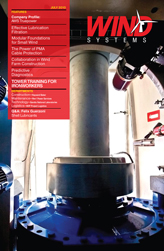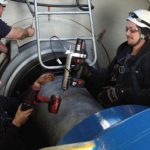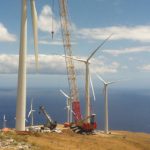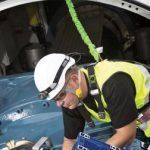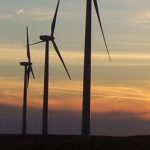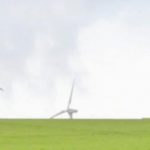The Hatchet Ridge Wind Farm is a 101.2-megawatt (MW) wind farm owned by Pattern Energy Group, LP. It is located in Shasta County, California, near Mount Shasta on a ridge overlooking the town of Burney and is the first large-scale wind farm in the area. The wind farm construction was announced in October 2009 with Renewable Energy Systems Americas, Inc., as the constructor. With anticipated generation to power nearly 44,000 California homes annually, the project is expected to finish and reach commercial operation before the end of 2010.
The project was delayed several months from its anticipated start date of March 2009 due to financial turbulence when Australian-based Babcock and Brown filed for bankruptcy and had to be reorganized. The North American development branch, which is the operating company that will run the Hatchet Ridge project, was sold off as part of the reorganization. The newly formed Pattern Energy had only been in existence for four months when they announced the construction start date for their first project; the Hatchet Ridge Wind Farm.
Pacific Gas and Electric Company (PG&E) will purchase the power, along with the renewable attributes, under a 15-year power purchase agreement. There are 44 Siemens 2.3 MW turbines, which stand on towers more than 20 stories tall that are being erected for this project. The Siemens SWT-2.3-93 wind turbine has more than 2,000 operating turbines worldwide, and it is well regarded throughout the industry as proven technology.
In comments made to the press Mike Garland, CEO of Pattern Energy, had the following to say about the project: “We are pleased to close financing and commence construction on the Hatchet Ridge Wind Farm,” he said. “This project is the result of years of dedication and collaboration with RES Americas, Siemens, PG&E, local government, project property owners, and the community. We are very appreciative for the local support we received that helped make this project a reality.”
Andrew Fowler, senior vice president of construction for RES Americas, said that “California is one of the top states in generating wind power capacity, and we are excited to continue to bring clean, renewable energy to the region and working with the local businesses in completing the project. Renewable energy brings economic benefits to the community and provides a secure and sustainable future for all.” Figure 1
Pattern Energy Group LP describes itself as an independent, fully integrated energy company that develops, constructs, owns, and operates renewable energy and transmission assets across the United States, Canada, and Latin America. With a long history in wind energy the group’s highly experienced team of scientists, engineers, construction experts, and legal and financial professionals has developed, financed, and placed into operation more than 2,000 MW of wind power in 11 states, including the 283.2 MW Gulf Wind project in Texas; a premier wind farm utilizing a ground-breaking wildlife monitoring system. Pattern’s development pipeline exceeds 4,000 MW of renewable energy projects, including the 101.2 MW Hatchet Ridge wind project in Northern California and the 138 MW St. Joseph wind project in Manitoba, Canada, that is currently under construction.
RES is one of the fastest growing renewable energy companies in the world, and it has been at the forefront of the wind industry since it was founded in 1982. It has been active in North America since 1997, and during this time it has either developed or constructed more than 10 percent of the installed capacity in the United States. As RES continues to grow it is beginning to apply its capabilities and experience in wind energy to solar energy and other emerging renewable systems. RES currently has 3,836 megawatts of operational renewable power, with 410 megawatts under construction.
Dashiell Corporation worked extensively with RES Americas in the months leading up to the official start date on the negotiation of the collector substation and the utility interconnect switchyard. Dashiell initially bid the project in early March 2009 and was given their first limited notice to proceed on the project in early June, 2009. As the financial turbulence discussed above progressed, Dashiell and RES were finally able to reach a full contract in October, 2009. At this time Dashiell was awarded the Hatchet Ridge 230kV/34.5kV collector substation and the Carberry 230kV switchyard on an engineering, procurement, and construction (EPC) basis.Figure 2
The Hatchet Ridge Collector substation consists of one 230kV, 2000A gas circuit breaker; one 230kV/34.5kV, 75/100/125 MVA power transformer; five 38kV, 1200A vacuum circuit breakers; and two 34.5kV, 10 MVAR capacitor banks. The substation has four incoming 34.5kV underground circuits from the wind farm and one outgoing 230kV overhead transmission line to the Carberry switching station. The Carberry switchyard consists of five 230kV gas circuit breakers and three incoming 230kV overhead transmission lines. One of the incoming transmission lines is from the Hatchet Ridge Wind Farm collector substation while the other two lines tie the new switching station into the PG&E power grid. Dashiell’s ability to design and construct these facilities to utility specifications proved valuable, as the Carberry switchyard will be owned and operated by PG&E once it is energized.
One of the many advantages that Dashiell can provide to these large scale wind farm projects is the coordination efforts that are required between the owner (Pattern Energy), the general contractor (RES), and the utility (PG&E) so that both the collector substation and the utility interconnect substation are built successfully and on time to meet the needs of the project. Dashiell has dealt with many utilities throughout the United States. Figure 3
With this wind farm being located near Mount Shasta, at high elevations in the Cascade Mountain range in Northern California, inclement weather has proven to be a major hurdle. The PG&E tie-in date for the Carberry switching station is this summer. With the high amount of snowfall that accumulates in the area late into the spring, the construction schedule has had numerous delays and has resulted in an accelerated construction schedule to meet project deadlines. Due to Dashiell’s substantial experience and resources in the substation construction industry, the Carberry switching station is still on target to meet its tie-in service date, and it is anticipated that the Hatchet Ridge Collector Substation will be ready for energization within that same time frame.
Some of the larger substation material items that go into wind farm projects are the primary voltage breakers, control houses, transformers, and steel structures, and each item requires its own foundation pad. These foundation pads are the first step in the substation construction efforts. After all of the concrete foundations have been laid and cured, the erection process can begin. This starts with setting the larger scale material items on their individual concrete foundation pad. A crane is set up and utilized to lift these heavy items off of the shipment crates and place them onto the poured concrete foundations. The control house at the Hatchet Ridge substation is approximately 50 feet in length. Figure 3 shows some of how this building eventually gets set. Figure 4
The transformers associated with these wind farm projects are generally quite big, both in terms of size as well as capacity. For the industrial projects that involve new substations you’ll typically see a 40 or 50 MVA max transformer. For this particular project the transformer has a base MVA rating of 75 and a full load MVA rating of 125—and this is a 101.2 MW wind farm. We see some wind farms that have 250 MW capacity. Also keep in mind that as the wind farm grows in capacity size, it starts to make more sense to utilize more than one transformer. But generally speaking, the transformers that are included with these wind farm collector substations are very large. Figure 5
Throughout the many phases of this project it has been obvious that without the hard work and coordination of Pattern Entergy, RES Americas, PG&E, and Dashiell working together during difficult financial times and bouts of extreme weather conditions, completion would not have been possible. In addition to providing clean, renewable energy for Californians, Hatchet Ridge has created approximately 100-200 construction jobs during the construction activities and will create as many as eight permanent jobs during operations. Pattern has also stated that they expect “an economic ripple effect in the area from the purchases of goods and services for the wind farm and the increased business for service industries.” In addition, “Hatchet Ridge will invest $5 million in the local community over the life of the project through the Shasta County General Fund, the Burney Regional Community Fund that will be administered by the Shasta Regional Community Foundation, and the Burney-Fall River Education Foundation, as well as pay substantial local taxes.” The benefits of this successful project are clear, and they are many.



















